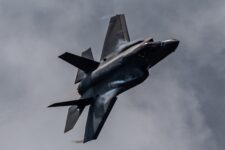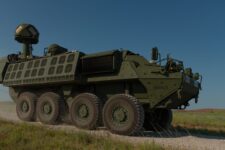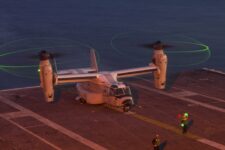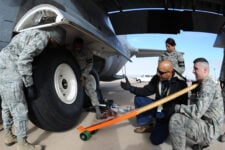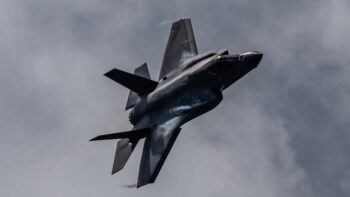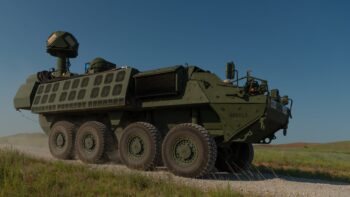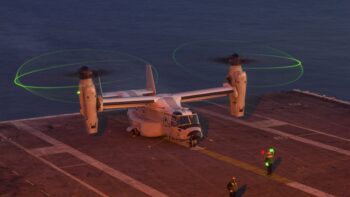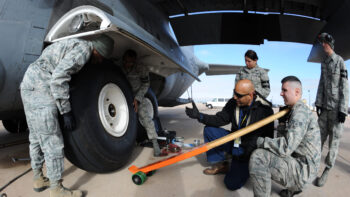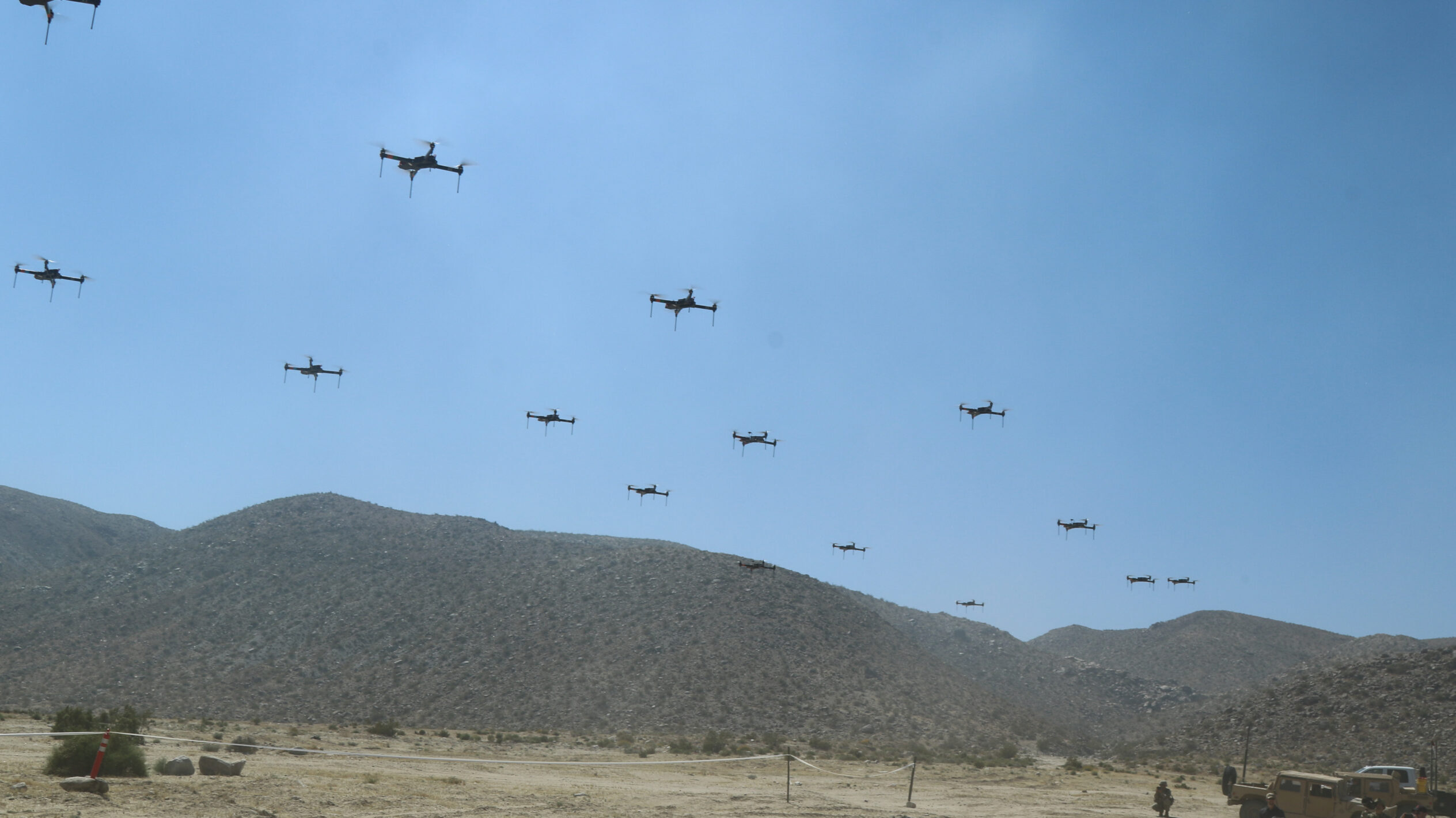
The 11th Armored Cavalry Regiment and the Threat Systems Management Office operate a swarm of 40 drones to test the rotational units capabilities during the battle of Razish, National Training Center on May 8th, 2019. (U.S. Army Photo by Pv2 James Newsome)
AUSA 2023 — Come June 2024, an Army innovation cell tasked with spearheading ways for the Pentagon to defend against small drones plans to host an ambitious new demonstration, asking industry to defeat a swarm of up to 50 flying robots in a test at White Sands Missile Range in New Mexico.
The demonstration, previewed by leadership of the Army’s Joint Counter Small Unmanned Aircraft Systems Office (JCO) during the Association of the United States Army (AUSA) convention earlier this month, marks the latest chapter in the Pentagon’s efforts to ramp up its defensive tech as drones proliferate on the battlefield in places like Ukraine and Israel.
Countering the small drone threat emerged as a key theme of AUSA this year, with industry players from the large primes to boutique firms offering their solutions, including guns, nets and lasers.
But there is “no silver bullet,” JCO Director Maj. Gen. Sean Gainey said at AUSA.
“No one system is going to be able to defeat all these threats. If somebody has that system, come see me. I’m looking to talk to you, and we have some money that we’ll be ready to invest in,” he added to his government and industry audience, surrounded by expensive convention floor displays put on by the Pentagon’s biggest contractors.
Demo Likely To Be ‘EW-Heavy’
The coming Army exercise will show “how our adversaries will try to overwhelm our air defenses and try to overwhelm our ability to counter small UAS [unmanned aerial systems],” said Col. Michael Parent, the JCO’s acquisition division chief.
The DoD categorizes drones in five different groups, with group 1 representing very small drones like quadcopters and group 5 designating the largest, like an MQ-9 Reaper. Gainey said his office’s focus is on the first three groups of drones, and already officials have identified successful counter-drone technologies.
“We found that a 30 millimeter gun is very effective against a small UAS,” Gainey said, pointing to other tech like the Army’s “signature” Coyote interceptor and Lockheed Martin’s MORFIUS system, which fries a drone’s electronics with microwaves.
Besides procurement of specific platforms, Gainey also said he’s a “huge fan” of buying counter-drone capabilities as-a-service, whereby vendors are given up-front, wide-ranging tasks like base defense to handle on their own. Parent said that after working with numerous contractors, JCO officials devised their own “list” so that “if a [military] service is looking for as-a-service requirement, these are who we’d recommend to do it,” though he did not disclose what vendors made the cut.
The JCO has a budget for prototyping, Parent explained to a group of reporters, but is not the final decision-maker on whether DoD buys a system. That choice is up to the military services, which can review the JCO’s work and decide if a capability tested by the office is suitable for a particular service’s need.
Some branches, like the Army, have already started equipping troops with counter small UAS, or C-sUAS, capability, according to Gainey, with two divisions fielded along those lines. The Army’s “intent is to go down to the platoon level with handheld capability in EW [electronic warfare],” he added.
That EW capability will be critical particularly for defeating swarms, Parent said when discussing the JCO’s upcoming anti-swarm demonstration. “Let’s face it, kinetic is challenged because we talked about [defeating] 20 to 50” drones, he said, noting that it could be an “EW-heavy” demo.
Additionally, the JCO’s work is already having real-world effects on the battlefield: an “Agnostic Gun Truck” developed by Northrop Grumman — where a 30 mm cannon is mounted on a Ford F250 — was demonstrated in January and was proven to be “very effective,” said Parent, adding that the platform is now headed to Ukraine.
“You can probably expect to see it on the ground very shortly, coming up here in the next quarter or so,” he said.
Different Vendors, Different Tactics
During AUSA, big primes like Britain’s BAE were touting modifications to their own platforms, which in BAE’s case would entail a new, “Picatinny-like rail” mounted on top of the company’s Armored Multi-Purpose Vehicle (AMPV) that could integrate a 30 mm cannon along with other combat tech. “We think we can put just about anything on an AMPV very quickly as a result,” said Jim Miller, BAE vice president of business development for combat mission systems in a briefing with reporters.
Smaller vendors, such as a company called Dedrone, were also exhibiting their own counter drone solutions. In Dedrone’s case, the company integrates third party equipment with their own software, though it also makes its own tech like radio frequency (RF) sensors to locate incoming threats.
As a result, Dedrone can provide a “turnkey counter-UAS capability,” Rob Campbell, Dedrone’s public sector vice president, said in an interview at the company’s booth on the AUSA show floor.
The war in Ukraine also provided the company a new opportunity. Earlier on in the conflict, the German defense ministry purchased about 20 of Dedrone’s RF sensors, but in the time since, approximately 250 of those sensors are now networked up and down the front lines, according to Campbell.
Asked what about the war in Ukraine surprised him when it came to drone warfare, Campbell responded by noting “how ill prepared Ukraine was to deal with it,” adding that the conflict is showing the Pentagon how critical it is to improve its own capabilities. Going forward, Campbell said he hoped that the Pentagon’s Defense Innovation Unit would play a greater role in bringing commercial technology to the DoD.
Jon Gruen, chief executive officer of Fortem Technologies, echoed Campbell’s observations about DoD being caught flat-footed by the drone threat.
“They were not EW-focused at all. We taught them what the real environment was in Ukraine. And they changed. You know, now everything has to be GPS-denied capable, jamming and all the rest,” Gruen said. “That all just got completely reworked in the last year.”
Gruen said Fortem’s DroneHunter C-sUAS solution, which uses one drone to shoot a net at a target drone, is being used extensively in Ukraine against smaller Iranian-made Shaheds. While Gruen was speaking to Breaking Defense, a group of Ukrainian military officials with the country’s border guard swung by Fortem’s booth to discuss the technology.
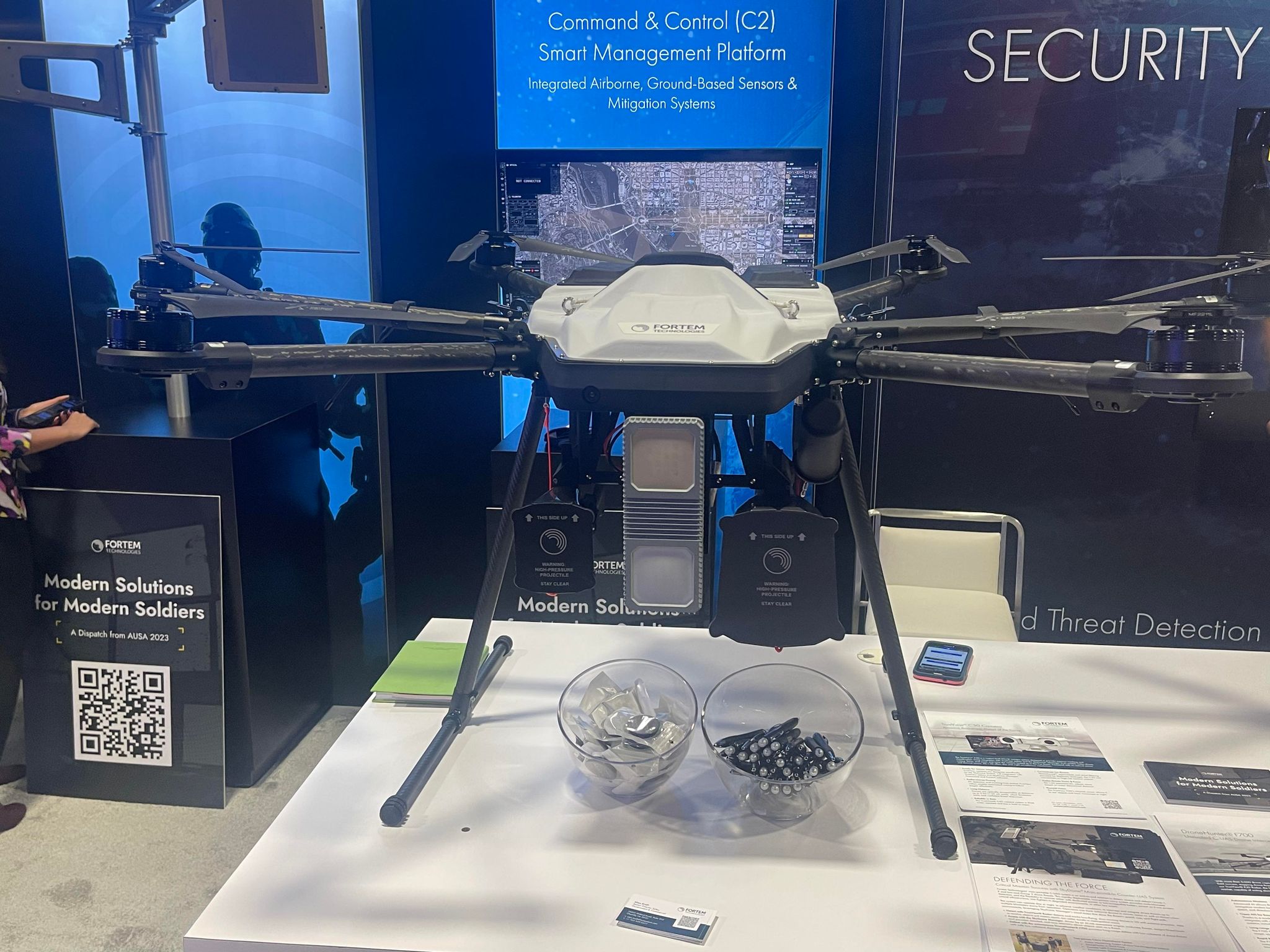
Fortem’s DroneHunter on display at AUSA 2023 (Michael Marrow/Breaking Defense).
Gruen said Fortem is exploring other uses for its DroneHunter platform, such as tasking it to search for mines, and that the Army has selected it as a low-collateral effects interceptor. Like other vendors, he also pointed to dual-use cases for civil missions, particularly critical enabling technologies like sensors and radars.
“All these core technologies are what’s going to evolve and go into what is the future of advanced air mobility on the commercial side. So we’re very much down that path in parallel as well,” he said.
While industry is eager to offer a range of solutions for warfighters, a JCO official made a point to show that defending against small drones can also be a somewhat straightforward task.
“I would like everybody to look up,” Lt. Col. Johnathan Hester, the JCO’s requirements officer, said during the office’s briefing on the AUSA show floor. “Alright, you have just had the first step of training for counter small UAS.”
